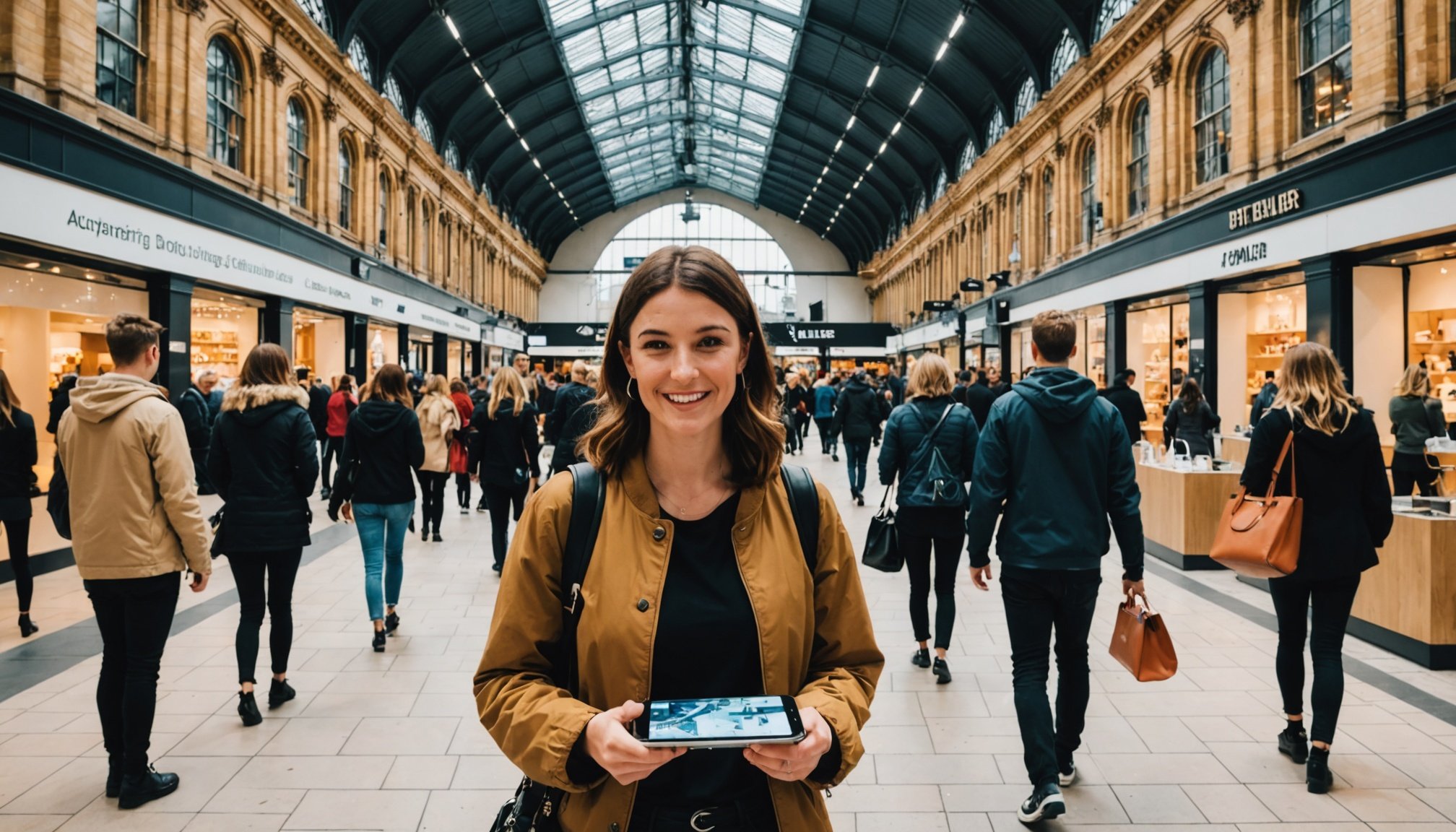Overview of Augmented Reality in Shopping
Augmented Reality (AR) is revolutionising the shopping experience by overlaying digital information on the physical world. This cutting-edge technology allows customers to interact with products more engagingly and immersively. Within the retail context, AR provides virtual try-ons of clothing, cosmetics, and accessories, significantly enhancing the buying process.
In Leeds Retail, the AR shopping landscape is vibrant and evolving. Several stores in Leeds have integrated AR into their operations, creating an innovative shopping environment that attracts tech-savvy consumers. These implementations range from virtual fitting rooms to interactive displays, offering consumers a high-tech way to shop.
Topic to read : Igniting Team Creativity: Leveraging Open-Source Tech in a Cambridge Research Lab
The importance of AR in the retail sector cannot be overstated. It enhances customer engagement by creating unique and memorable experiences. Shoppers are more likely to feel connected to a brand when they can visualise products in their personal space, leading to higher satisfaction and loyalty. Furthermore, AR can increase store footfall and online traffic, as consumers are drawn to the interactive and personalised shopping experience it offers.
In conclusion, Augmented Reality represents a pivotal development in retail, transforming how consumers perceive and interact with brands, particularly in innovative hubs like Leeds.
Also to see : Boosting Visitor Interaction in Glasgow Cafes: Leveraging Influencer Collaborations for Business Growth
Participating Retailers in Leeds
Leeds boasts a dynamic retail scene where augmented reality offers shoppers unique experiences. Various retailers using AR have transformed the city’s shopping landscape. They provide customers with engaging, tech-driven experiences that seamlessly blend digital and physical worlds.
Major Retailers Implementing AR
Several key players in Leeds shopping have embraced AR, setting themselves apart through innovative technology integration. Retail giant H&M has integrated AR mirrors that enable virtual outfit try-ons, enhancing customer engagement. Similarly, John Lewis offers immersive AR catalogues, allowing clients to visualise furniture in their homes without lifting a finger. This not only captivates customers but also significantly boosts sales figures.
Emerging Local Brands
Beyond the major retailers, smaller brands are making noise with creative AR implementations. Local boutique Hopscotch has introduced personalised AR shopping assistants, guiding customers through their product range in a truly interactive manner. These emerging local brands are drawing attention by integrating quirky and unique AR offerings, proving that technology integration can be a compelling tool for growth. Through these pioneering efforts, they are broadening their customer base and sparking local consumer interest. The rapid growth in awareness and adoption demonstrates AR’s potential to redefine the retail experience in Leeds.
Benefits of Augmented Reality Try-On Experiences
Augmented Reality (AR) offers groundbreaking benefits of AR virtual try-ons that traditional shopping cannot match. These experiences enhance the customer satisfaction by letting shoppers visualise products on themselves before purchasing.
Virtual try-ons provide a high level of personalization and convenience, allowing consumers to experiment with different styles and products seamlessly. For instance, a customer can try out a new shade of lipstick or see how a watch might look on their wrist without stepping out of their home. This convenience eliminates the need for fitting rooms and crowded stores, providing a stress-free shopping experience.
Moreover, augmented reality significantly boosts consumer confidence in their purchase decisions. Seeing a product in a real-world context helps shoppers assess its suitability more accurately, leading to better-informed choices and reducing the instances of returns. This level of assurance adds to customer satisfaction and loyalty, as they are more likely to return to retailers offering such innovative solutions.
Additionally, AR try-ons attract tech-savvy shoppers eager to explore new ways to shop, thereby increasing footfall and online engagement. Virtual try-ons blend the digital and physical shopping realms, creating an experience that aligns with modern consumers’ expectations.
How to Access Augmented Reality Experiences
Accessing augmented reality experiences in shopping is increasingly streamlined, bringing the digital world to consumers’ fingertips. Whether you are in Leeds or beyond, AR apps are essential tools that enable these transformative experiences.
Downloading and Setting Up AR Apps
To start, finding and downloading the right AR app is crucial. Popular apps like IKEA Place, which allows users to visualise furniture in their space, and beauty apps like YouCam Makeup offer enriched shopping experiences. After downloading, follow user-friendly guides to set up the app on your smartphone or tablet. Ensure your device is AR-compatible for seamless operation.
In-Store vs. At-Home AR Experiences
In-store AR experiences, like virtual fitting rooms, provide an immediate and interactive touchpoint, blending tactile shopping with digital aids. At-home AR apps offer convenience, allowing exploration and decision-making from the comfort of your space.
To maximise these experiences, engage actively with app features, adjust settings for optimal visuals, and if in-store, seek guidance from staff to enhance your interaction with AR tools. By bridging physical and digital shopping, AR enhances overall customer satisfaction and engagement, creating an evolving landscape for consumer interaction.
Customer Testimonials and Feedback
Augmented Reality (AR) shopping experiences have garnered significant interest from consumers, reflected in a range of insightful user reviews. Many customers appreciate how AR technology enhances their shopping journey, offering unique insights into customer experience enhancements. A prevailing sentiment among users is the excitement and satisfaction derived from virtual try-ons, which add convenience by allowing customers to visualise products without needing physical interaction.
One compelling case involves users expressing heightened confidence and satisfaction after engaging with AR tools. Being able to preview products like clothing or furniture directly within their physical environment has reduced return rates and improved decision-making. The user feedback frequently highlights the accuracy and realism of augmented reality representations, leading to greater trust in their purchasing choices.
Another common theme is the anticipation of future technology advancements in AR shopping applications. Consumers are eager to explore even more innovative features, such as enhanced personalisation through AI-driven suggestions and more intuitive interfaces. These desires indicate a robust demand for continuous improvement and innovation in AR experiences. This feedback signals to retailers the importance of integrating and evolving AR tools to meet the dynamic expectations of a tech-savvy customer base.
Future Trends in Augmented Reality Shopping
The future of retail is poised for transformation with the continuous evolution of augmented reality (AR) technologies. Emerging AR innovations are set to redefine the shopping experience, offering consumers novel ways to engage with retailers and products. As technology advances, we anticipate several trends gaining traction.
Firstly, expect to see more immersive AR experiences that leverage artificial intelligence. These interfaces will deliver deeper levels of personalisation, tailoring product suggestions to individual user preferences based on browsing and purchase histories. The fusion of AI with AR will enhance the consumer journey, making it not just interactive, but intuitive.
Moreover, the increased adoption of mobile AR platforms means on-the-go shopping in virtual environments is becoming a reality. Retailers are exploring virtual storefronts where consumers can browse, try, and buy items without stepping into a physical location. This trend aligns perfectly with the modern need for convenience and personalised shopping.
Finally, the integration of social AR features is set to impact consumer behavior profoundly. By incorporating social networks into AR, users can share shopping experiences instantly, adding a communal aspect to purchasing decisions. This fosters a blend of community engagement and individual retail experiences.











